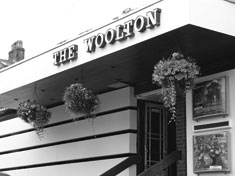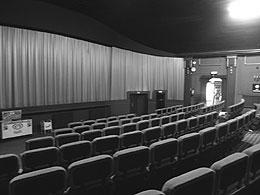
| HOME |
| NERVE |
| REVIEWS |
| ARCHIVE |
| EVENTS |
| LINKS |
| ABOUT US |
| CONTRIBUTORS |
| BACK ISSUES |
| CONTACT US |
Back to index of Nerve 9 - Autumn 2006
 Before
the rise of television there was a golden age of cinema. Local picture
houses acted as luxurious havens of escapism and could be found in almost
every district of Liverpool. Several of these picture houses survived
the television boom, but the emergence of the modern multiplex was a near
fatal blow to independent cinema.
Before
the rise of television there was a golden age of cinema. Local picture
houses acted as luxurious havens of escapism and could be found in almost
every district of Liverpool. Several of these picture houses survived
the television boom, but the emergence of the modern multiplex was a near
fatal blow to independent cinema.
Independent Cinema
Several relics of this glorious era still remain around Liverpool today,
but their existence is sadly in jeopardy.
The city’s only remaining single screen cinema - the Woolton Cinema,
which had been going strong for over seventy-nine years, offering cinema
enthusiasts the ‘complete’ experience, an old-fashioned presentation
replete with plush seats and an atmosphere reminiscent of that golden
age - has now closed.
In 1992, the Woolton was purchased by David Wood, whose family had a long and illustrious history in the world of independent cinema. His grandfather John Wood opened Liverpool’s first purpose-built cinema - the Bedford Hall in Walton - and later went on to found the Bedford cinema chain. David’s father Tony eventually took over the chain, employing David in distribution as well as the cinema-running side of the business. Sadly, David Wood recently passed away at the age of 59, following complications from a liver complaint, leaving the future of the Woolton Cinema hanging in the balance. Tributes poured in from cinema lovers across the city, many of whom claim that Wood’s death marks the end of an era. For the time being it remains open, with a number of people interested in buying the site, but it is too early to say what the long-term future holds.
Woolton is not the only district keeping the big screen alive in Merseyside. The Plaza Community Cinema in Waterloo was established in 1997 following a successful campaign by local residents. The cinema is entirely dependent on donations from public and private sectors but the building would benefit most from a complete renovation. The board of trustees have campaigned tirelessly to a variety of sources for the funding required to secure the future of one of independent cinema’s last bastions in Liverpool.
 The
future of The Plaza looks uncertain. The board of trustees have had limited
success with funding and now face an uphill struggle to maintain a very
old building in need of constant care and maintenance. The board are now
appealing to locals for their support in keeping this community amenity
alive.
The
future of The Plaza looks uncertain. The board of trustees have had limited
success with funding and now face an uphill struggle to maintain a very
old building in need of constant care and maintenance. The board are now
appealing to locals for their support in keeping this community amenity
alive.
The future of local cinemas may look bleak, but February 2003 saw the unveiling of the FACT Centre, which remains the only cinema in the city to show foreign films. Unlike Manchester’s Cornerhouse, the cinema at Fact is not subsidised and is therefore reliant on profit to sustain itself. This means that screening of big blockbusters is inevitable but FACT’s dedication to arthouse and foreign cinema has been unwavering over the years. Since 2003 the FACT has gone from strength to strength and is a worthy flagship for the Capital of Culture in 2008.
Independent cinema in Liverpool is still very much alive. In addition to the FACT, the Philharmonic Hall occasionally holds screenings of classic films; often with an organ recital beforehand. The Bluecoat Chambers was once dedicated to arthouse cinema before it switched its focus to other media. However, it would be a great loss to Liverpool if the last remaining relics of the city’s cinematic history were to disappear. The Plaza and the Woolton are the glowing embers of what was once a great fire; they should not be left to fizzle out.
Sorry Comments Closed
Comment left by Maggi on 17th June, 2007 at 19:20
what has happened to this cinema? is it still opearting because i saw the piece on save our cinema on the five news.
thanks
Comment left by David A Ellis on 14th November, 2007 at 17:46
Great article. I worked for Bedford cinemas at the Mayfair Aigburth. I was the second projectionist from 1969 until its closure in 1973. Projectors were Kalee 11s. They ran the very first and last films. When I was there xenons provided screen illumination, housed in Cineemeccanica lam houses. Before those Kalee Regal lamp houses were employed ith carbons providing the light. The bases were Westar, the top spool Kalee and the bottom Westar. 5000ft spoolboxes were used, fitted for 3D. When 3D finished the boxes were retained and we would join two reels together to cut down on changeovers. Projectomatic was also in use, allowing automatic changeovers. The non-sync, or record playing machine was an old stle autochanger that was employed on old record players. However we only put one record on the player at a time.Four track magnetic stereo was used at the Mayfair. Films I screened in four track were Funny Girl, Where Eagles Dare and a three week run of Woodstock. A downside of the projectomatic at the Mayfair was when it started a machine for a changeover the sound would drop out for a split second. In 1969 a floating screen was installed at the mayfair. There were no tabs and no masking. When we changed over on wide screen the picture would jump over slightly.In 1973 the last film screened was The Last Picture Show. The last night didn't attract many patrons, so the cinema had a not so memorable end. It became a Mecca bingo club and was demolished in the eighties. A superemarket now stands on the site that once stood the super Mayfair.